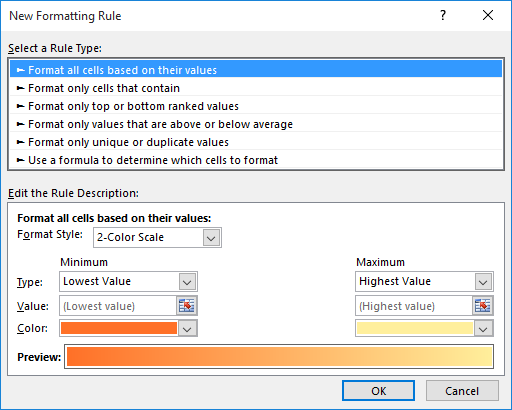Written by Allen Wyatt (last updated December 30, 2023)
This tip applies to Excel 2007, 2010, 2013, 2016, 2019, 2021, and Excel in Microsoft 365
Amol has 1,000 values in an Excel worksheet, occupying 100 rows of 10 columns each. Each value in this range is an integer value between 0 and 99. Amol needs a way to count and display all the values which are odd and greater than 50.
There are a few ways you can go about counting and displaying, but it is important to understand that these are different tasks. Perhaps the best way to display those values that fit the criteria is to use conditional formatting. You can add a conditional formatting rule to each cell that will make bold or otherwise highlight the desired values. Follow these steps:

Figure 1. The New Formatting Rule dialog box.

Figure 2. The Format Cells dialog box.
If you prefer, you could also use the following formula in step 6:
=AND(ISODD(A1),A1>50)
To get the count of cells that fit the criteria, you could use an array formula:
=SUM(MOD(MyCells,2)*(MyCells>50)
This formula assumes that the range of cells you want to analyze are named MyCells. Don't forget to enter the cell using Ctrl+Shift+Enter. (This is not necessary if you are using Excel in Microsoft 365; just press Enter.) If you don't want to use an array formula, you could use the following:
=SUMPRODUCT((MOD(MyCells,2)*(MyCells>50))
You could also use a macro to derive both the cells and the count. The following is a simple version of such a macro; it places the values of the cells matching the criteria into column M and then shows a count of how many cells there were:
Sub SpecialCount()
Dim c As Range
Dim i As Integer
i = 0
For Each c In Range("A2:J101")
If c.Value > 50 And c.Value Mod 2 Then
i = i + 1
Range("L" & i).Value = c.Value
End If
Next c
MsgBox i & " values are odd and greater than 50", vbOKOnly
End Sub
Note:
ExcelTips is your source for cost-effective Microsoft Excel training. This tip (12597) applies to Microsoft Excel 2007, 2010, 2013, 2016, 2019, 2021, and Excel in Microsoft 365.

Best-Selling VBA Tutorial for Beginners Take your Excel knowledge to the next level. With a little background in VBA programming, you can go well beyond basic spreadsheets and functions. Use macros to reduce errors, save time, and integrate with other Microsoft applications. Fully updated for the latest version of Office 365. Check out Microsoft 365 Excel VBA Programming For Dummies today!
Using Excel to maintain lists of information is not unusual. When working with the list you may need to determine how ...
Discover MoreWhen working with large amounts of data, it can be tricky to figure out how to extract just the information you need. ...
Discover MoreDo you want Excel to take the case of your text into account when it does comparisons in a formula? The IF statement ...
Discover MoreFREE SERVICE: Get tips like this every week in ExcelTips, a free productivity newsletter. Enter your address and click "Subscribe."
2023-12-30 09:51:48
J. Woolley
Re. the formula (which was missing the final parenthesis)
=SUM(MOD(MyCells,2)*(MyCells>50))
the Tip says, "Don't forget to enter the cell using Ctrl+Shift+Enter." I don't think this is necessary because the formula does not return an array.
Got a version of Excel that uses the ribbon interface (Excel 2007 or later)? This site is for you! If you use an earlier version of Excel, visit our ExcelTips site focusing on the menu interface.
FREE SERVICE: Get tips like this every week in ExcelTips, a free productivity newsletter. Enter your address and click "Subscribe."
Copyright © 2026 Sharon Parq Associates, Inc.
Comments